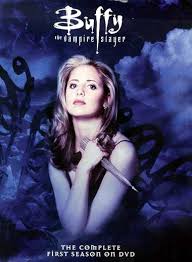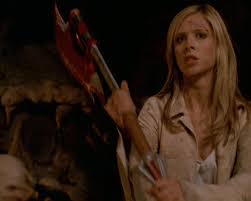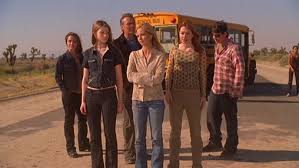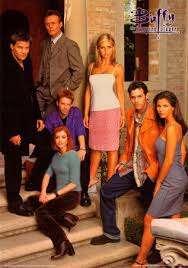Buffy the Vampire Slayer: 7 years of (mostly) greatness.
To start things off, here's my review of Buffy: The Vampire Slayer that I wrote nearly 7 years
ago. It's worth mentioning that in that time I have rewatched the entire series from beginningto end at least once and it still holds up. I have actually noticed that there is far more wrong with it than I originally thought but actually the times when Buffy doesn't quite
work - when it falls flat on its face, even - somehow only help to make such a special s
how.
So, here you go. My review of my favourite TV show to date:
From epinions.com (Originally published 19 April 2004)

Buffy the Vampire Slayer is a show that should never have worked. Consider the source: a D-Grade camp-horror flick about a ditsy teenage girl who fights vampires that was slammed by the critics and ignored by the public – not exactly the most promising basis for a television show. Worse, the person responsible for writing this abysmal failure of a film was the very man who charged with the task of bringing it to the small screen. Nonetheless, despite some shaky foundations and aside for continuously being snubbed by the Emmy Awards, Buffy the Vampire Slayer TV show was – hell, still is – a resounding success.

In a day of safe sitcoms (Scrubs and Malcolm in the Middle excluded of course) and safer reality television shows, Whedon’s willingness to take risks with his show only seems more impressive. ‘Safe’ and ‘static’ are two words that should never be applied to Buffy the Vampire Slayer because ultimately Buffy is a show that pushes – and at times demolishes – boundaries. Take for instance that hardly new practice of killing off major characters: unlike most shows when a character is killed off in Buffy it never comes off as some major marketing ploy but as a shocking – and I mean genuinely shocking – events that always carries some fairly heavy consequences. In the interest of keeping this near-spoiler free, I won’t go into any details but deaths in season three and season six acted as both turning points for the story lines of the respective seasons as well as genuinely shocking moments in and of themselves.
Actually, when all is said and done, the riskiest move of all was Whedon’s decision to use a paranormal show as a vehicle for him to express himself. Paranormal shows never exactly earn the respect of the general public so his decision to hide the real story of growing up and finding ones place in the world behind vampires and demons was a bold one but this was one risk that paid off. Though some still scoff at the very idea of Buffy the Vampire Slayer, it was his decision to use demons and other forces of evil as metaphors for real-life troubles that allowed Whedon to create a show that realistically explored the lives of teenagers and young adults but managed to be massively entertaining at the same time.
 Now, after referring to the wonderful characterization yet again, it’s about time for a look at the show’s greatest strength – the characters and the actors that portray them. Buffy may have some of the snappiest dialogue you’ve ever heard; it may include exciting action scenes, intense drama, hilarious comedy, terrifying scenes of horror and it may be terrifically directed – and it does include all of these things – but it’s the characters that make the show special. We have an eclectic group of characters, all of which are almost always likable, almost always complex and almost always relatable that throughout their stay on the show (and Angel as well) are constantly evolving. With a constantly changing roster of characters, the show managed to amass quite the substantial amount of main characters – so much so that delving into each and everyone would take more time than I intend to devote to this review.
Now, after referring to the wonderful characterization yet again, it’s about time for a look at the show’s greatest strength – the characters and the actors that portray them. Buffy may have some of the snappiest dialogue you’ve ever heard; it may include exciting action scenes, intense drama, hilarious comedy, terrifying scenes of horror and it may be terrifically directed – and it does include all of these things – but it’s the characters that make the show special. We have an eclectic group of characters, all of which are almost always likable, almost always complex and almost always relatable that throughout their stay on the show (and Angel as well) are constantly evolving. With a constantly changing roster of characters, the show managed to amass quite the substantial amount of main characters – so much so that delving into each and everyone would take more time than I intend to devote to this review.
Buffy the Vampire Slayer is a show that should never have worked. Consider the source: a D-Grade camp-horror flick about a ditsy teenage girl who fights vampires that was slammed by the critics and ignored by the public – not exactly the most promising basis for a television show. Worse, the person responsible for writing this abysmal failure of a film was the very man who charged with the task of bringing it to the small screen. Nonetheless, despite some shaky foundations and aside for continuously being snubbed by the Emmy Awards, Buffy the Vampire Slayer TV show was – hell, still is – a resounding success.
It may never have amassed the ratings of Friends or ER but it did manage to garner a cult following that managed to match, if not surpass those cult stalwarts, Star Trek and Star Wars in both magnitude and intensity. Even more surprising was the acclaim it received from even the most mainstream of critics - not to mention the multitudes of papers written about it by genuine, honest-to-goodness academics. Whedon was so successful at setting up such a wonderfully realized universe, peopled with some of television’s most memorable characters, that when Buffy spawned a spin-off, Angel, it actually managed to live up to its parent show.
Ultimately though, I’m reviewing Buffy not because of the accolades its received but because it’s MY favourite hour-long television show. I genuinely identified with and cared for the characters and truly found myself becoming invested in the various story lines that ran through the show. Now, several months after the series finale rapped up, I feel the need to take a look back at the show that redefined my outlook on television as a storytelling medium.
Much like many others, my Buffy obsession began when I was in my mid-teens. Also much like many others, I found myself drawn to the show not because I expected quality drama and exceptional storytelling but because, well, it was about a hot girl who goes around slaying vampires. Vampires and hot girls – how could any sci-fi/fantasy geek in his mid-teens pass it up? While Buffy did land up offering an assortment of evil nasties just waiting to get their collective heads (and other body parts) handed to them by our rather attractive heroine, it also, much to my surprise, offered so much more.
Boasting some of the most innovative, compelling story lines and some of the most likable, most relatable and most complex characters ever to appear on our silver screen, Buffy quickly proved itself to be a show that could stand up to, match and even defeat TV’s most acclaimed drama shows. My age also helped me to appreciate another aspect of the show that I might not have picked up had I not been sixteen (the same age as the characters on the show) when I began watching the show. Unlike Dawson’s Creak and the like, Buffy the Vampire Slayer was a show that, as a teenager, I could RELATE to.
It didn’t matter that I was living in circumstances that had nothing to do with what the characters on the show were going through, I still found myself experiencing – or at least feeling – much of what the characters were going through. Plus, there was the added bonus that these characters actually talked, acted and looked like real – honest to goodness REAL – teenagers. Even more impressively, Whedon had the foresight and the guts to age the characters in “real
time”. This meant that not only did the characters never look older than they were, it allowed them the chance to actually develop from teenagers to young adults and considering I saw roughly one season a year, it meant I was always the same age as them.
Of course, you don’t need to be a teenager to appreciate Buffy but you probably will need an open mind. Everything from the abundance of supernatural happenings to the stylized teen-speak to the campy-as-hell title requires the viewer to redefine his or her understanding of what quality television is. For many, many people good quality television can only come in the form of so-called “realistic” shows – generally the kind that involve lawyers or doctors – and the very idea of a show with a title like Buffy the Vampire Slayer would send them running. If, however, you ignore the stigma attached to the fantasy genre in general as well as being prepared to accept that a show can teenagers at the center of the show without it becoming one of those average-at-best teen-dramas, you should find plenty to enjoy. I already – very briefly – mentioned some of the things that make Buffy great but these do need to be expanded upon.
In a day of safe sitcoms (Scrubs and Malcolm in the Middle excluded of course) and safer reality television shows, Whedon’s willingness to take risks with his show only seems more impressive. ‘Safe’ and ‘static’ are two words that should never be applied to Buffy the Vampire Slayer because ultimately Buffy is a show that pushes – and at times demolishes – boundaries. Take for instance that hardly new practice of killing off major characters: unlike most shows when a character is killed off in Buffy it never comes off as some major marketing ploy but as a shocking – and I mean genuinely shocking – events that always carries some fairly heavy consequences. In the interest of keeping this near-spoiler free, I won’t go into any details but deaths in season three and season six acted as both turning points for the story lines of the respective seasons as well as genuinely shocking moments in and of themselves.
Still, though effective character deaths are rare things in television, for Buffy they are only the tip of the iceberg. Perhaps the most impressive example of Whedon’s inventiveness are the so-called “format breaking” episodes. Examples of this include a musical episode (‘Once More With Feeling’), an episode almost entirely lacking dialogue (Hush) and an episode that moves the spotlight onto what should be the “b” plot while relegating the ‘a’ plot to the sidelines (The Zeppo). Whedon and the rest of his writing team constantly try to experiment with television conventions but unbelievably, as far as I can recall, every last one of these are roaring successes.
It’s all very well trying out new things but the experiments need to succeed on a dramatic level. Whedon was also willing to take characters (and plot lines) in directions that might not necessarily gel well with the fans but whether it was making Willow, Buffy’s best friend, gay or turning most of the characters into near-unlikable, problem-riddled versions of their former selves in season six; his artistic vision was always firmly in place. The characters may have become unlikable for that period but they remained as real and oddly sympathetic as ever and as for Willow’s sexual orientation it was handled with respect and honesty and thus never came close to becoming a mere stunt to satisfy the politically correct among us.
Actually, when all is said and done, the riskiest move of all was Whedon’s decision to use a paranormal show as a vehicle for him to express himself. Paranormal shows never exactly earn the respect of the general public so his decision to hide the real story of growing up and finding ones place in the world behind vampires and demons was a bold one but this was one risk that paid off. Though some still scoff at the very idea of Buffy the Vampire Slayer, it was his decision to use demons and other forces of evil as metaphors for real-life troubles that allowed Whedon to create a show that realistically explored the lives of teenagers and young adults but managed to be massively entertaining at the same time.
By telling genuinely absorbing stories, Buffy never became some trite soap opera and managed to subtly examine some real issues that affect teens or twenty-somethings. One of the better examples of this is the examination of premarital sex when Buffy sleeps with Angel, the vampire with a soul and Buffy’s first major love interest and causes him to lose his soul, turning him into Angelus – Angel’s evil self. Aside for the moral undertones of this, it also acted as a critical turning point plot-wise in the second season by turning one of the Slayer’s greatest allies into one of her greatest enemies.
As for the storytelling to be found, as you may have gathered by now, each season has its own story arc. These yearlong stories generally find our heroes facing off against different “Big Bads”, which have included such a diverse lot as mayors, ex-boyfriends, demigods, Frankenstein monsters, major vampires and even one of the core group of Buffy’s friends. This decision to allow a larger, overall story to develop over the course of each season gave the show a sense of direction and cohesiveness that more episode-based storytelling would never have been able to provide. Not that most of the episodes don’t stand up well by themselves but they take on a whole new level when you view them as part of the whole.
As for the storytelling to be found, as you may have gathered by now, each season has its own story arc. These yearlong stories generally find our heroes facing off against different “Big Bads”, which have included such a diverse lot as mayors, ex-boyfriends, demigods, Frankenstein monsters, major vampires and even one of the core group of Buffy’s friends. This decision to allow a larger, overall story to develop over the course of each season gave the show a sense of direction and cohesiveness that more episode-based storytelling would never have been able to provide. Not that most of the episodes don’t stand up well by themselves but they take on a whole new level when you view them as part of the whole.
Take, for example, the afore mentioned musical episode - an episode that is an unequivocal success thanks to a tight, imaginative script; note-perfect performances; excellent direction and some surprisingly good musical numbers but when viewed within the context of the show as a whole it takes on a whole new level of excellence. The music in the episode served a greater purpose of revealing the inner most feelings and secrets that had been building up in the characters over the course of the season. Anyone who had not been watching religiously from at least the beginning of that season would not have appreciated these nuances in the same way as someone who had. Needless to say, those who had been watching these characters develop from season one probably enjoyed this episode most of all.
At its core though, were four characters: Buffy Summers, Willow Rosenburg, Xander Harris and Rupert Giles who would be there for the entirety of the shows run – though admittedly, except for Buffy herself, the amount of screen time they received was always changing. Buffy, being the star of the show was always the central character and as such became one of the most complex characters. Starting off as a typical American teenage girl, the role of the slayer was a burden, constantly getting in the way of her social life. As the show progressed she became more and more accustomed to her role as the Chosen One but she still continued to strive for a balance of her duties with a more normal life. She matured from a bratty, spoilt girl into a mature, responsible woman with a level of believability that most shows could only dream of.
Even more startling was Willow’s procession from a shy, socially inept computer geek who liked blokes to a strong-willed, powerful witch (or wicca) who liked the ladies. Xander, on the other hand never completely overcame his, shall we say, social problems and was one of the few characters who never developed super powers but he constantly became more and more self-assured and his role as the heart and soul of the group became more and more profound. Giles, in the meantime went from being the groups stern, stuffy British authority figure to a more relaxed, more complex and more loving parent figure.
The other characters are no less impressive but I’ll leave it for you, dear reader, to discover these wonderful personalities. Of course this is TV so it matters not whether these characters are excellent on paper, if you don’t have actors that can bring them to life; they would be nothing but wasted potential. Fortunately, Whedon managed to assemble a truly spectacular cast of previously little-known actors. Everyone from Alysson Hannigan to Tom Lenk make their characters, no matter how extraordinary, seem like real, breathing people (or vampires or whatever). At the heart of it all though, is the wonderful Sarah Michelle Gellar as Buffy who carried the entire show with the grace and style of a true pro.
And so we come to the end of this meandering review but before I leave you, I’ll just leave you with a short, concise reason to buy those DVD sets or to catch the old reruns. Buffy is a show that fuses fantasy, horror, science fiction, comedy, romance, drama, and action into a perfectly realized synthesis of these diverse genres. If you’re a fan of any of these – or especially if you’re a fan of most of these – genres you owe it to yourself to get yourself some Buffy the Vampire Slayer. “Why”, you ask? Well, with engaging storylines; lively, snappy dialogue; sharp humour; exciting action scenes; rich character driven drama; genuine innovation, exceptional acting and of course some of the greatest characters to ever grace the silver screen, Buffy succeeds on every possible level.










South African readers buy the Complete Buffy Boxset at Take 2 or Start off with Season 1 and move onto Seasons two, three, four, five, six and seven.
International readers check out Amazon.com for the complete box set or the individual seasons of Buffy:
And so we come to the end of this meandering review but before I leave you, I’ll just leave you with a short, concise reason to buy those DVD sets or to catch the old reruns. Buffy is a show that fuses fantasy, horror, science fiction, comedy, romance, drama, and action into a perfectly realized synthesis of these diverse genres. If you’re a fan of any of these – or especially if you’re a fan of most of these – genres you owe it to yourself to get yourself some Buffy the Vampire Slayer. “Why”, you ask? Well, with engaging storylines; lively, snappy dialogue; sharp humour; exciting action scenes; rich character driven drama; genuine innovation, exceptional acting and of course some of the greatest characters to ever grace the silver screen, Buffy succeeds on every possible level.
South African readers buy the Complete Buffy Boxset at Take 2 or Start off with Season 1 and move onto Seasons two, three, four, five, six and seven.
International readers check out Amazon.com for the complete box set or the individual seasons of Buffy:

Comments
Post a Comment